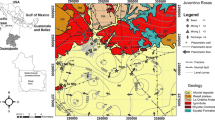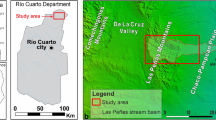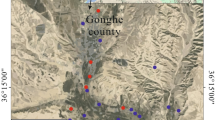Abstract
Arsenic and fluoride groundwater concentrations over national standards for drinking water were measured in the regional aquifer of Juventino Rosas, Guanajuato State, Central Mexico. Also anomalous temperature occurs in groundwater wells of the area. Concentrations of total dissolved solids, silica, and chloride are too low to indicate a geothermal heat source. Additionally, isotopic evidence indicates that groundwater from the studied wells is subject to an evaporation process affected by the humid weather of the zone. The chemical characteristics of the water indicate a deep circulation warm water system in normal geothermal gradient. The warm waters of Juventino Rosas are mainly of three types: Water type I: (Na–HCO3), represented by the highest temperature wells and presence of fluoride and arsenic; water type II (Na–Ca–HCO3) that represents a mixing process between water types I and III. In this group, the sample 13JR contained high concentration of F−; water type III (Ca–HCO3), represented only by one sample (Cen 2) located over the outcrop of shales, limestones, and metamorphic rocks. This sample contains the highest concentrations of sulfate, manganese, and iron. All the geological and geochemical evidences indicate that rhyolite units are the most probable source of As and F−. The area corresponds to a low-temperature and low-enthalpy system and not to a well defined geothermal system.





Similar content being viewed by others
References
Ahn JS (2012) Geochemical occurences of arsenic and fluoride in bedrock groundwater: a case study in Geumsan County, Korea. Environ Geochem Health 34:43–54
APHA, AWWA and WWF (2005) Standard methods for the Examination of Water and Wastewater. American Public Health Association, the American Water Works Association, Association Water Environment Federation, Washington, DC
Appelo CAJ, Postma D (1993) Geochemistry, groundwater and pollution. Balkema, Rotterdam
Armienta MA, Segovia N (2008) Arsenic and fluoride in the groundwater of Mexico. Environ Geochem Health 30:345–353
Arnórsson S (1975) Application of the silica geothermometer in low temperature hydrothermal areas in Iceland. Am J Sci 275:763–784
Arnórsson S (1983) Chemical equilibria in icelandic geothermal systems. Implications for chemical geothermometry investigations. Geothermics 12:119–128
Cardona BA, Carrillo Rivera JJ, Armienta MA (1993) “Elementos Traza: Contaminación y Valores de Fondo en Aguas Subterráneas de San Luis Potosí, SLP, México”. Geofis Int 32:277–286
Carrillo JJ, Armienta MA (1989) Diferenciacion de la Contaminación Inorgánica en las aguas Subterráneas del Valle de la Ciudad de San Luis Potosí, SLP, México. Geofis Int 28–4:763–783
Carrillo-Chávez A, Morton-Bermea O, González-Partida E, Rivas-Solorzano H, Oesler G, García-Meza V, Hernández E, Morales P, Cienfuegos E (2003) Environmental geochemistry of the Guanajuato Mining District, Mexico. Ore Geol Rev 23:277–297
Cerca-Martínez LM, Aguirre-Díaz GJ, López-Martínez M (2000) The geological evolution of the southern Sierra de Guanajuato; a documented example of the transition from the Sierra Madre Occidental to the Mexican Volcanic Belt. Int Geol Rev 42:131–151
Christiansen EH, Sheridan MF, Burt DM (1986) The geology and geochemistry of Cenozoic topaz-rhyolites from western United States. Geol Soc Am Spec Pap 205:1–82
Comisión Nacional del Agua (CONAGUA) (2009) Actualización de la disponibilidad media anual de agua subterránea acuífero (1115) valle de Celaya, Estado de Guanajuato. Gerencia de evaluación y ordenamiento de acuíferos. Diario oficial de la Federación, Agosto
Coplen T (1988) Normalization of oxygen and hydrogen isotope data. Chem Geol (Isotope Geoscience Section) 72:293–297
Craig H (1961) Isotopic variations in meteoric waters. Science 1961(133):1702–1703
Dahlkamp FJ (2010) Uranium deposits of the world. USA and Latino America editor. Springer, Berlin
Del Razo LM, Arellano MA, Cebrian ME (1990) The oxidisation states of arsenic in well-water from a chronic arsenicism area of Northern Mexico. Environ Pollut 64:143–153
Díaz-Barriga F, Leyva R, Quistian J, Loyola-Rodríguez JB, Pozos A, Grimaldo M (1997) Endemic fluorosis in San Luis Potosi, Mexico. Fluoride 30:219–222
Echegoyén-Sánchez J, Romero-Martínez S, y Velázquez-Silva S (1970) Geología y yacimientos minerales de la parte central del Distrito Minero de Guanajuato: México. Boletín del Consejo de Recursos Naturales no Renovables 75:1–36
Ellis AJ, Mahon WAJ (1977) Chemistry and geothermal system. Academic Press, New York, p 391
Ferrari L (2000) Avances en el conocimiento de la Faja Volcánica Transmexicana durante la última década. Boletín de la Sociedad Geológica Mexicana 53:84–92
Fournier RO (1977) Chemical geothermometers and mixing models for geothermal system. Geothermics 5:41–50
Garrels RM, Mackenzie FT (1971) Evolution of sedimentary rocks. W. W. Norton & Co., New York
Gibson JJ, Birks SJ, Edwards WD (2008) Global prediction of δA and δ2H-δ18O evaporation slopes for lakes and soil water accounting for seasonality. Global Biogeochem Cycles 22:GB2031
Giggenbach WF (1988) Geothermal solute equilibria. Derivation of Na-K-Mg-Ca geoindicators. Geochim Cosmochim Acta 52:2749–2765
Giggenbach WF (1992) Isotopic shifts in waters from geothermal and volcanic systems along margins, and their origin. Earth Planet Sci Lett 113:495–510
Hair JF Jr, Anderson RE, Tatham RL, Black WC (1999) Análisis multivariante, 5th edn. Prentice Hall Iberia, Madrid, p 832
Hem JD (1985) Study and interpretation of chemical characteristics of natural water, 3rd edn. U.S. Geological Survey, Water supply paper
Henley RW, Ellis AJ (1983) Geothermal systems ancient and modern: a geochemical review. Earth Sci Rev 19:1–50
Henley RW, Truesdall AH, Barton PB Jr, Whitney JA (1984) Fluid-mineral equilibria in hydrothermal systems. Reviews in economic geology, vol 1. Society of Economic Geologists, Chelsea
Hochstein MP (1990) Classification and assessment of goethermal resources. In: Dickson MH, Fanelli M (eds) Small geothermal resources. UNITAR/UNDP Centre for Small Energy Resources, Rome, pp 31–59
Issar A, Quijano JL, Gat JR, Castro M (1984) The isotope hydrology of the groundwaters of Central Mexico. J Hydrol 71:201–224
Karingithi CW (2009) Chemical geothermometers for geothermal exploration. In: Short Course IV on Exploration for Geothermal Resources: United Nations University, Geothermal Training Program, Lake Vaivasha, Kenya, 1–22 November
Kharaka YK, Callender E, Carothers WW (1977) Geochemistry of geopressured geothermal waters from the Texas Gulf Coast. In: Proceedings of 3rd Geopressured-Geothermal Energy Conference 1, pp G1121–G1165
Kotoky P, Barooah PK, Baruah MK, Goswami A, Borah GC, Gogoi HM, Ahmed F, Gogoi A, Paul AB (2008) Fluoride and endemic fluorosis in the Karbi Anglong district, Assam, India. Fluoride 41:72–75
López DL, Bundschuh J, Birkle P, Armienta MA, Cumbal L, Sracek O, Cornejo L, Ormachea M (2012) Arsenic in volcanic geothermal fluids of Latin America. Sci Total Environ 429:57–75
Luo ZD, Zhang YM, Ma L, Zhang GY, He X, Wilson R, Byrd DM, Griffiths JG, Lai S, He L, Grumski K, Lamm SH (1997) Chronic arsenicism and cancer in Inner Mongolia—consequences of well water arsenic levels greater than 50 mg l1. In: Abernathy CO, Calderon RL, Chappell WR (eds) Arsenic exposure and health effects. Chapman and Hall, London, pp 55–68
Mejía JA, Rodríguez R, Armienta A, Mata E, Fiorucci A (2007) Aquifer vulnerability zoning, an indicator of atmospheric pollutants input? Vanadium in the Salamanca aquifer, Mexico. Water Air Soil Pollut 185:95–100
Meybeck M (1987) Global chemical weathering of surficial rocks estimated from river dissolved loads. Am J Sci 287:401–428
Morales I (2014) Geological hydrogeological and geothermal factors associated to the origin of arsenic, fluoride and high groundwater temperature in a volcanic environment: El Bajio Guanajuatense. Ph D Thesis, Earth Sciences Posgraduate Program. UNAM, Mexico, p 112
Michard G, Sanjuan B, Criaud A, Fouillac C, Pentcheva EN, Petrov PS, Alexieva R (1986) Equilibria and geothermometry in hot alkaline waters from granites of S.W. Bulgaria. Geochem J 20:159–171
Mifflin MD (1968) Delineation of groundwater flow systems in Nevada: University of Nevada-Reno, Desert Research Institute, Technical Report Series H-W, Hydrology and Water Resources Publication 4. Reno. Desert Research Institute, University of Nevada-Reno, Nevada
Mifflin MD (1988) Region 5, Great Basin. In: Back W, Rosenshein JS, Seaber PR (eds) Hydrogeology, vol O-2. Geological Society of America, The Geology of North America, Boulder, pp 69–86
Nicholson K (1993) Geothermal fluids: chemistry and exploratin techniques. Springer, Berlin
NOM-127-SSA1-1994. Norma Oficial Mexicana “Salud ambiental, agua para uso y consumo humano-límites permisibles de calidad y tratamientos a que debe someterse el aguapara su potabilizacion”
Nordstrom DK (2011) Quality of our groundwater resources—arsenic and fluoride. Geosciences 13:82–87 (Water’s Role in the Earth System)
Orozco-Esquivel MT, Nieto-Samaniego AF, Alaniz-Alvarez SA (2002) Origin of rhyolitic lavas in the Mesa Central, Mexico, by crustal melting related to extension. J Volcanol Geoth Res 118:37–56
Piper AM (1944) A graphic procedure in the geochemical interpretation of water analyses. Am Geophys Union Trans 25:914–923
Quijano LJL, Velázquez MN (1985) Evaluación Geoquímica de zonas termales en el Estado de Guanajuato. Comisión Federal de Electricidad. Subgerencia de Estudios Geotérmicos. Departamento de Exploración Informe 4–85
Robertson FN (1989) Arsenic in ground water under oxidizing conditions, south-west United States: environmental Geochemical. Health 11:171–185
Rodríguez R, Reyes R, Rosales J, Berlín J, Mejía JA, Ramos A (2001) Estructuración de mapas temáticos de índices de vulnerabilidad acuífera de la mancha urbana de Salamanca Gto. Municipio de Salamanca, Technical Report Inedit, CEAG, IGF-UNAM
Rodríguez R, Armienta A, Morales P, Silva T, Hernández H (2006) Evaluación de Vulnerabilidad Acuífera del valle de Irapuato Gto. Reporte Técnico JAPAMI, CONCyTEG, IGF UNAM
SARH Secretaria de Agricultura y Recursos Hidraulicos (1970) Origen termalismo en el sector suroeste del estado de San Luís Potosí y Norte de Guanajuato, Asociado a depósitos lacustres y actividad volcánica riolítica del Terciario, elaborado por estudios geotécnicos SA
Schaef HT, McGrail BP, Owen AT (2010) Carbonate mineralization of volcanic province basalts. Int J Greeen House Control 4:249–261
Serna-Vigueras R, Nava-Arrieta J (1958) Yacimientos de alunita en la región de Romero, Guanajuato, Consejo de Recursos Naturales y No renovables, departamento de exploración
Smedley PL, Kinninbeurg DG (2002) A review of the source, behavior and distribution of arsenic in natural waters. Appl Geochem 17:517–568
Torres-Rodríguez V, Arellano GV (2000) La Energía Geotérmica en México. UNAM, Programa Universitario de Energía, México
Trujillo Candelaria JA (1985) Subsidencia de terrenos en la ciudad de Celaya Gto. Soc Mex de Mec de Suelos I:35–42
Velázquez-Aguirre L, Ordaz-Ayala A (1992) Provincias Hidrogeológicas de México. Boletín de la Sociedad Geológica Mexicana 3:1–19
Wassenaar LI, Van Wilganburg SL, Larson K, Hobson KA (2009) A groundwater isoscape (D, 18O) for Mexico. J Geochem Explor 102:123–136
Webster JG, Nordstrom DK (2003) Geothermal Arsenic. In: Welch AH, Stollenwerk KG (eds) Arsenic in ground water: geochemistry and occurrence. Kluwer Academic Publishers, Boston, pp 101–126
Wen D, Zhang F, Zhang E, Wang C, Han S, Zheng Y (2013) Arsenic, fluoride and iodine in groundwater of China. J Geochem Explor 135:1–21
Werner RA, Brand WA (2001) Referencing strategies and techniques in stable isotope ratio analysis. Rapid Commun Mass Spectrom 15:501–519
Yokoyama T, Banfield JF (2002) Direct determinations of the rates of rhyolite dissolution and clay formation over 52,000 years and comparison with laboratory measurements. Geochim Cosmochim Acta 66:2665–2681
Acknowledgments
The research was financed by the PAPIIT UNAM Grant, Num IN102113 and partially by the Grant 207032-2013-04 of the Centro Mexicano de Innovación en Energía Geotérmica (CeMIE-Geo), Fondo Sectorial Conacyt-Sener-Sustentabilidad Energética. CMAPAJR Juventino Rosas dwellers helped in groundwater sampling campaigns. Chemical analyses were done by Aguayo A., Ceniceros N., Cruz O., and Hernandez-Mendiola E.
Author information
Authors and Affiliations
Corresponding author
Rights and permissions
About this article
Cite this article
Morales, I., Villanueva-Estrada, R.E., Rodríguez, R. et al. Geological, hydrogeological, and geothermal factors associated to the origin of arsenic, fluoride, and groundwater temperature in a volcanic environment “El Bajío Guanajuatense”, Mexico. Environ Earth Sci 74, 5403–5415 (2015). https://doi.org/10.1007/s12665-015-4554-9
Received:
Accepted:
Published:
Issue Date:
DOI: https://doi.org/10.1007/s12665-015-4554-9




